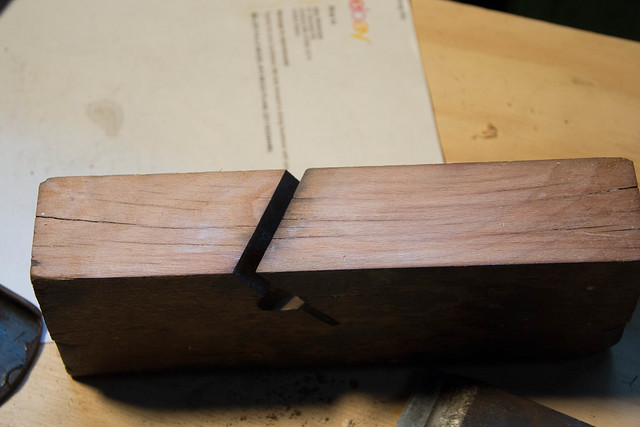Among them was a box with a bunch of hand planes in it. Some of them were basically in new condition: the Stanley #3 needed to be sharpened and adjusted, but that was about it. The Stanley #78 may not ever have been actually used: some of the parts still had what appeared to be packing grease on them, and it was all in the original box.
Then there were a few much older planes. Among them were a coffin plane, which is in good shape except that the iron needs to be re-ground, and this.

It's a skew rabbet plane, in somewhat rough shape. It's wide, too: something like 2 or 2 1/2". The iron has been sharpened down to almost nothing (there might be as much as 3/4" remaining before it's too short to use, but I suspect it's more like 1/2"), and the bottom was actually rippled. I started out by getting the iron and wedge loose, which was quite a challenge. The iron had more or less rusted in place, and I wound up having to smack it pretty hard with a hammer to get it to move. Once it was out, I sanded it down. The good news was that it had been kept at the right grinding angle, so I didn't have to regrind from scratch, just get rid of the rust and then sharpen.
Here's a photo from partway through: you can see how much of the iron is gone.

I also touched up the wedge on sandpaper to get rid of the rust, but I did my best to avoid changing the shape at all.
Next up was dealing with the sole. This was the part I was worried about. I needed to remove something like a 1/8", which seemed impractical to do with sandpaper. I knew, though, that the sole was a little shorter than the sole of my #5, so it seemed likely that I just joint it. As it turned out, it worked fine; really old beech planes nicely, and I managed to get the sole at exactly 90 degrees to the left side. That should mean it will register correctly against the edge of a rabbet, and actually cut a square joint. In the process, though, I discovered something unpleasant.

Yep, those are cracks that run all the way from the toe to the heel. In the end, I decided to just leave it. Right now the plane can be used; it cuts smoothly, and feels solid. If I ever have some hide glue on hand I may rub some into the joint, but otherwise I'll simply use it until it breaks. At that point, I'll glue it back together and either keep using it or, more likely, retire it to a shelf as a reminder of my grandfather.
No comments:
Post a Comment